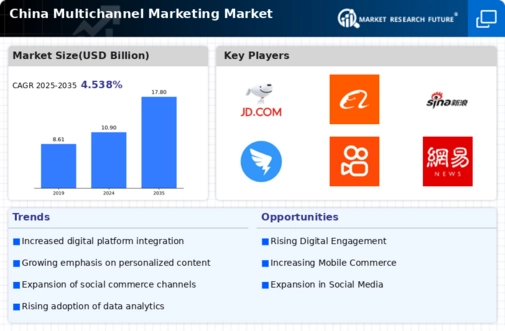The multichannel marketing market in China is characterized by a dynamic competitive landscape, driven by rapid technological advancements and evolving consumer preferences. Key players such as Salesforce (US), Adobe (US), and Oracle (US) are at the forefront, leveraging their extensive resources to innovate and expand their service offerings. Salesforce (US) has positioned itself as a leader in customer relationship management (CRM) solutions, focusing on integrating AI capabilities to enhance customer engagement. Adobe (US), with its robust suite of creative and marketing tools, emphasizes digital transformation, enabling businesses to create personalized experiences across multiple channels. Meanwhile, Oracle (US) is concentrating on data-driven marketing strategies, utilizing its vast database to provide insights that help businesses optimize their marketing efforts. Collectively, these strategies contribute to a competitive environment that is increasingly focused on technological integration and customer-centric solutions.
The business tactics employed by these companies reflect a nuanced understanding of the market's structure, which appears to be moderately fragmented. Localizing services and optimizing supply chains are critical tactics that enhance operational efficiency and responsiveness to local market demands. The influence of major players is substantial, as they not only set industry standards but also drive innovation that smaller firms must adapt to in order to remain competitive.
In October 2025, Salesforce (US) announced a strategic partnership with a leading Chinese e-commerce platform to enhance its multichannel marketing capabilities. This collaboration aims to integrate Salesforce's CRM solutions with the e-commerce platform's extensive customer data, allowing businesses to deliver more targeted marketing campaigns. The strategic importance of this partnership lies in its potential to significantly improve customer engagement and conversion rates, thereby solidifying Salesforce's position in the Chinese market.
In September 2025, Adobe (US) launched a new suite of AI-driven marketing tools tailored specifically for the Chinese market. This initiative is designed to empower local businesses to leverage data analytics for more effective marketing strategies. The introduction of these tools is strategically significant as it aligns with the growing demand for personalized marketing solutions, positioning Adobe as a key player in the digital transformation of marketing practices in China.
In August 2025, Oracle (US) expanded its cloud marketing platform by incorporating advanced machine learning algorithms to enhance predictive analytics capabilities. This enhancement allows businesses to anticipate customer behavior more accurately, thereby optimizing their marketing strategies. The strategic relevance of this development is profound, as it not only strengthens Oracle's competitive edge but also reflects the increasing importance of data analytics in shaping marketing decisions.
As of November 2025, the competitive trends in the multichannel marketing market are increasingly defined by digitalization, sustainability, and the integration of AI technologies. Strategic alliances are becoming more prevalent, as companies recognize the value of collaboration in enhancing their service offerings and market reach. Looking ahead, competitive differentiation is likely to evolve from traditional price-based competition to a focus on innovation, technological advancement, and supply chain reliability. This shift underscores the necessity for companies to adapt and innovate continuously in order to maintain a competitive advantage in a rapidly changing market.





















Leave a Comment